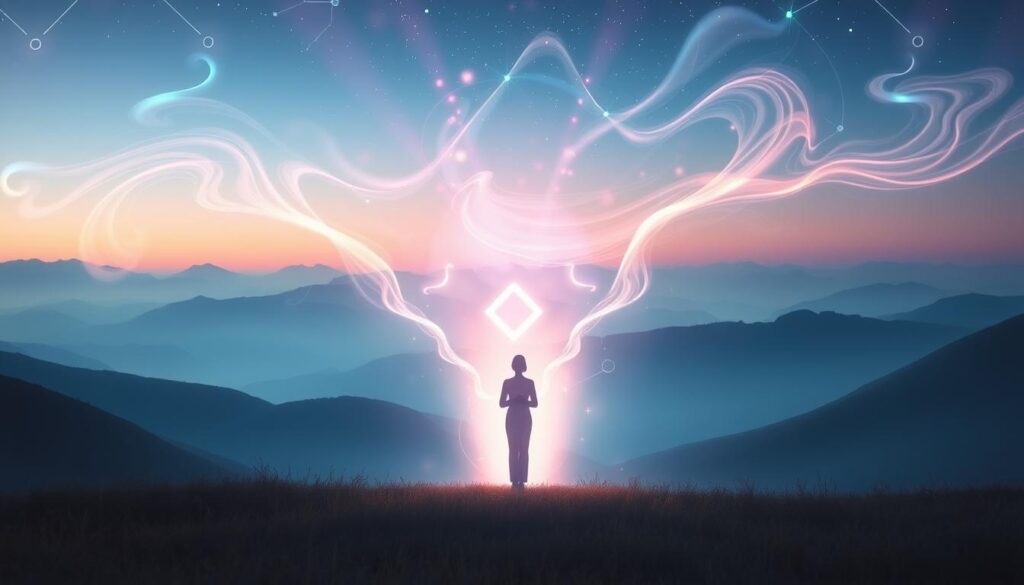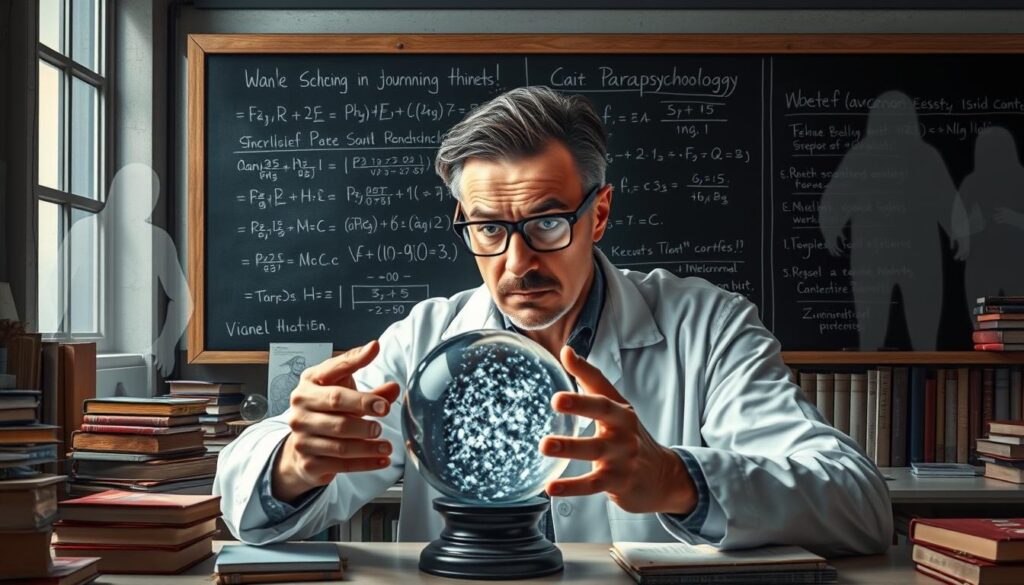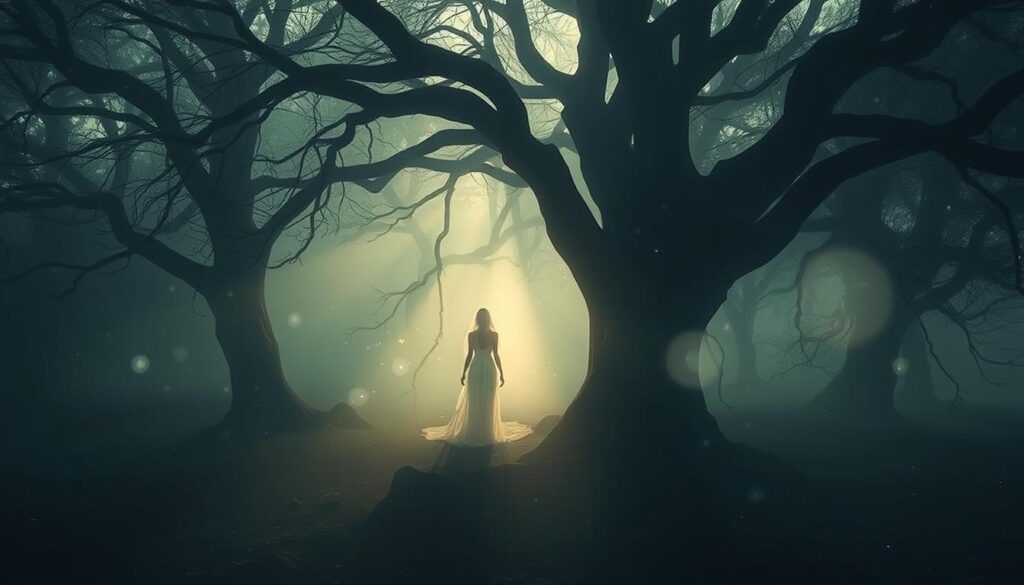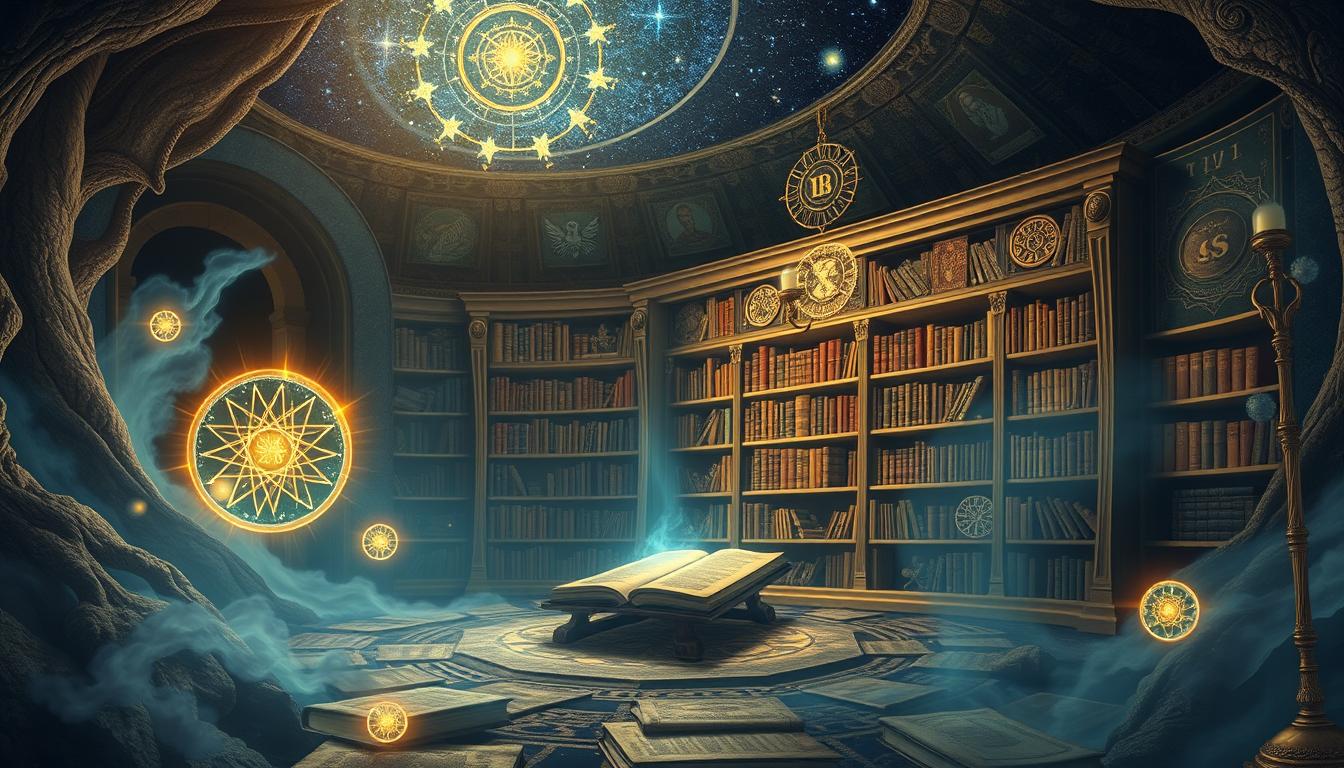Ever thought about supernatural abilities or paranormal events? Parapsychology explores these mysteries. It looks into extrasensory perception, psychokinesis, and anomalous cognition. Mainstream science might doubt it, but researchers keep searching for proof.
Parapsychology started in the late 1800s. Max Dessoir coined the term in 1889. The Society for Psychical Research (SPR), founded in London in 1882, was key. It brought together experts to study telepathy, hypnotism, and more.
Early studies showed mixed results. Some people did better in clairvoyance tests than others. Despite this, J.B. Rhine kept studying extrasensory perception and psychokinesis in the 1930s.
Today, parapsychology is still debated. Mainstream science journals rarely publish on it. But, studies have found interesting links. For example, believing in ESP can lead to better test results. Creativity and extroversion also seem to play a role.
Key Takeaways
- Parapsychology is the study of alleged supernatural abilities and paranormal phenomena
- The field emerged in the late 19th century, with the Society for Psychical Research playing a key role
- Early experiments yielded mixed results, but researchers like J.B. Rhine continued to investigate ESP and psychokinesis
- Mainstream science largely views parapsychology as a pseudoscience, with research seldom published in mainstream journals
- Meta-analyses have revealed intriguing connections between belief, personality traits, and ESP performance
Introduction to Parapsychology
Parapsychology is a field that explores the mysteries of psychic phenomena and psi research. It aims to understand the enigmas beyond ordinary science. This discipline looks into experiences that can’t be explained by natural laws and how we might gain knowledge beyond our senses.
At its heart, parapsychology studies things like extrasensory perception (ESP) and psychokinesis (PK). Researchers work hard to uncover the truth behind these extraordinary experiences. They’ve been fascinating humans for centuries.
The study of parapsychology started in the late 19th century. The spiritualist movement was growing, and a group of curious minds formed the Society for Psychical Research in Britain in 1882. This marked the start of parapsychology’s scientific journey.
In 1889, Max Dessoir coined the term “parapsychology.” It linked this new field to psychology. Since then, researchers have focused on ESP, PK, and the survival hypothesis.
Today, parapsychology faces big challenges. A survey showed funding issues, lack of career paths, and limited journal access are major problems. These hurdles make it hard for researchers to do their work.
| Challenge | Description |
|---|---|
| Lack of Funding | Insufficient financial support for research and teaching in parapsychology |
| Undefined Career Path | Absence of clear professional opportunities and advancement in the field |
| Limited Journal Access | Difficulty in publishing parapsychological research in mainstream academic journals |
Parapsychology also faces a crisis of confidence. Skepticism and criticism have grown. This calls for more scientific investigation and evidence-based research.
Despite these challenges, parapsychology remains captivating. Books like “Introduction to Parapsychology” by Harvey J. Irwin and Caroline A. Watt are still popular. This book offers a deep dive into parapsychology, covering its history and latest research.
“Parapsychology is the scientific study of experiences which, if they are as they seem to be, are in principle outside the realm of human capabilities as presently conceived by conventional scientists.”
– Harvey J. Irwin and Caroline A. Watt, “Introduction to Parapsychology”
As we explore parapsychology, let’s keep an open mind and critical eye. By delving into human potential and science, we might uncover secrets beyond the ordinary. This could expand our understanding of the world and ourselves.
The History of Parapsychology
The roots of parapsychology go back to the late 19th century. This was when people started to show more interest in psychical research. The Society for Psychical Research (SPR) was founded in 1882. It aimed to study spiritualism and psychic abilities through science.
Early Psychical Research
Before the SPR was formed, people like Robert Hare and Agenor de Gasparin were researching. Their work was a starting point for studying paranormal events. But, mainstream scientists saw them as not real scientists.
The Society for Psychical Research (SPR)
The SPR was started in 1882 by Dawson E. Rogers. It was the first big group focused on psychical research. They looked into things like telepathy and Spiritualism’s physical side. Yet, some mediums they supported were thought to be fake.
| Period | Years | Characteristics |
|---|---|---|
| Early Scientific | 1880-1930 | Establishment of SPR, early psychical research |
| Mid-Scientific | 1930-1970 | J.B. Rhine’s laboratory at Duke University, use of statistical tools |
| Late Scientific | 1970-present | Emergence of parapsychology as a discipline, decline in the US |
Early Clairvoyance Experiments
Charles Richet and J. M. Peirce did early experiments on clairvoyance. They tried to see if people could get information without using their senses. But, these early tests were not always clear, making scientists even more doubtful.
Parapsychology studies are unfortunately low in volume compared with other academic disciplines like physics or chemistry, indicating a scarcity of research in this field.
Even with the hurdles, the work of early researchers set the stage for parapsychology. Groups like the SPR and figures like Henry Sidgwick and Charles Richet helped start a scientific study of the paranormal. Their efforts opened the door for more research in the field.
Key Figures in Parapsychology
Many influential figures have shaped parapsychology over the years. They have helped us understand and study psychic phenomena. Their work has led to modern research and experiments.
J.B. Rhine
J.B. Rhine is known as the father of modern parapsychology. He worked at Duke University in the 1930s. Rhine introduced the term “parapsychology” and focused on experimental methods.
His experiments tested extrasensory perception (ESP) with card guessing and dice rolling. Despite criticism, Rhine’s work made parapsychology a part of academic research. It inspired many future researchers.
Charles Richet
Charles Richet was a French physiologist and Nobel laureate. He was an early member of the Society for Psychical Research (SPR). Richet studied clairvoyance, trying to show how people can sense things beyond normal senses.
Richet used playing cards and sealed envelopes in his experiments. His results were not always consistent. Yet, his work laid the groundwork for future research and highlighted the possibility of psychic abilities.
Eleanor Sidgwick
Eleanor Sidgwick was a key figure in the SPR. She focused on apparitional experiences and hallucinations in mentally healthy people. Sidgwick aimed to distinguish between real psychic experiences and those caused by psychological factors.
Sidgwick’s research showed the importance of careful investigation in parapsychology. She emphasized the need for rigorous scientific methods when studying psychic phenomena.
| Researcher | Contribution |
|---|---|
| J.B. Rhine | Coined the term “parapsychology” and conducted experiments on ESP at Duke University |
| Charles Richet | Early SPR member and Nobel laureate who conducted clairvoyance experiments |
| Eleanor Sidgwick | SPR president who investigated apparitional experiences and hallucinations in the mentally healthy |
These pioneers have greatly influenced parapsychology. Their work has inspired many to explore the mysteries of the human mind. They have helped us understand abilities beyond our current scientific knowledge.
Extrasensory Perception (ESP)
Extrasensory perception, or ESP, is a fascinating area of study within parapsychology. It includes telepathy, clairvoyance, and precognition. The Parapsychological Association calls these abilities psi-gamma. This means getting information in ways other than our known senses or logic.

The Zener card deck is a well-known tool in ESP research. It was first used in the 1930s at Duke University. In a typical telepathy experiment, a “sender” looks at cards while a “receiver” tries to guess the symbols. Despite many trials, like W. S. Cox’s study at Princeton University, there’s still no solid proof of ESP.
Telepathy
Telepathy is the idea of communicating between minds without using our senses. Many people believe in telepathy, like between twins or close family members. But, science has found it hard to prove it through controlled experiments.
Clairvoyance
Clairvoyance, or “second sight,” is seeing or knowing things that are hidden without using our senses. Many claims of clairvoyance have been made, like Joaquin María Argamasilla in the early 20th century. But, most have been explained away as tricks or mistakes.
| ESP Type | Description | Example |
|---|---|---|
| Telepathy | Communication between minds | A mother sensing her child’s distress from afar |
| Clairvoyance | Perception of hidden objects or events | A psychic claiming to locate a missing person |
| Precognition | Knowledge of future events | A dream that seemingly predicts a future disaster |
Precognition
Precognition is knowing future events before they happen. These experiences often involve accidents, deaths, or disasters. Some studies, like the ganzfeld experiments, show results above chance. But, the science world is still unsure because there’s no clear explanation and possible flaws in the research.
Despite many people believing in ESP, scientists mostly see it as pseudoscience. There’s no solid theory and not enough positive results from experiments. Yet, the interest in ESP shows how complex and mysterious human experiences can be. It highlights the need for ongoing, open-minded scientific study.
Psychokinesis (PK)
Psychokinesis, also known as telekinesis or mind-over-matter, is a fascinating area of study within parapsychology. It involves the investigation of physical events that occur without any apparent motor involvement. The Parapsychological Association categorizes psychokinesis as psi-kappa, a term used to describe the mind’s ability to influence matter.
One of the most well-known examples of psychokinesis is the poltergeist phenomenon. This involves the unexplained movement of objects, often attributed to supernatural forces. Parapsychologists believe that these events may be caused by unconscious psychokinetic activities, often in the presence of adolescents. In fact, during a field investigation of Recurrent Spontaneous Psychokinesis (RSPK), disturbances were observed in the presence of an adolescent boy, suggesting the involvement of unconscious psychokinetic abilities.
Parapsychologists often prefer to measure subtle manifestations of psychokinesis through refined measurement techniques rather than obvious demonstrations like levitating objects or bending spoons. Micro-PK research, which focuses on the mind’s influence on microscopic events, has been a preferred laboratory approach for several decades. This approach gained momentum in the 1930s when a young gambler claimed he could influence the fall of dice using sheer willpower, leading to experiments at Duke University’s parapsychology lab.
J.B. Rhine, a key figure in modern parapsychology, conducted experiments using dice as ‘target’ systems to study individuals’ ability to influence random events. Researchers at the Rhine have also observed psychokinesis effects on an Egley Wheel in a controlled setting, with no physical forces identified to cause the observed effects.
| Experiment | Results |
|---|---|
| Coin toss prediction (no psychic ability) | Correct prediction ~50% of the time |
| Coin toss prediction (with psychic ability) | Correct prediction >50% of the time |
| Micro-PK effects on random number generators | Results exceeding chance variations |
| Effects of emotion on electronic devices | Emotional situations influence electronics behavior |
Other notable studies in the field of psychokinesis include research on mental entanglement with a photomultiplier located approximately 7,300 km from participants. This study showed an increase of approximately 5% in detected photons compared to control periods, replicating findings from previous experiments.
The evidence for psychokinesis is intriguing and warrants further investigation. While skeptics may dismiss these phenomena, the scientific study of psychokinesis continues to yield fascinating results.
Parapsychology and Mainstream Science
Parapsychology studies psychic phenomena like telepathy and psychokinesis. It’s a topic of debate in science. Mainstream science sees it as a pseudoscience.
Many say there’s no solid proof for psychic abilities, despite a century of research. Scientists claim parapsychology doesn’t follow scientific standards. It often uses stories and weak experiments.

Parapsychology is also not in top scientific journals. This makes it seem like it’s not a real science.
Criticisms of Parapsychology
Scientific skepticism towards parapsychology comes from several points. Critics say its results can’t be repeated. They also say there’s no clear theory for psychic powers.
They also point out that parapsychology uses statistical tricks and after-the-fact explanations. They believe these tricks can explain away any psychic claims.
Parapsychology as a Pseudoscience
Most scientists think parapsychology is a pseudoscience. It looks like science but isn’t. Pseudosciences rely on old ideas, stories, and avoid peer review.
“Extraordinary claims require extraordinary evidence.” – Carl Sagan
Yet, some researchers keep studying psychic phenomena. They say we should give parapsychology a fair shot. They believe it could lead to new insights into our minds and reality.
Parapsychology Research Methods
Parapsychology uses many research methods to study things that science can’t explain. These include experimental parapsychology, statistical analysis, meta-analysis, and replication studies. The goal is to prove these experiences using science and understand how they work.
In experimental parapsychology, researchers try to remove all known ways of influencing results. They then use statistics to see if what they found could happen by chance. Meta-analysis combines data from many studies to find patterns in parapsychology research.
Field research looks into experiences like precognitive dreams and telepathic impressions. It helps find out how common these experiences are and who has them. Spontaneous case studies dive deeper into people’s experiences with psi, helping us understand their personal meanings.
But, parapsychologists face a big challenge: replicating results. Many studies can’t be repeated, which makes mainstream scientists skeptical. In fact, most scientists don’t think parapsychology is real science.
| Organization | Year Founded |
|---|---|
| Society for Psychical Research | 1882 |
| American Society for Psychical Research | 1885 |
| Parapsychological Association | 1957 |
Despite the challenges, groups like the Society for Psychical Research keep studying psi phenomena. In 1969, the Parapsychological Association even got recognized by the American Association for the Advancement of Sciences. This gave parapsychology some credibility.
Parapsychology is the study of apparent anomalies of behavior and experience that exist apart from currently known explanatory mechanisms that account for organism-environment and organism-organism information and influence flow.
Parapsychology keeps growing, with researchers still trying to understand psi phenomena. Even though many are skeptical, as Christopher French said in 2018, the field still draws people who believe in the unknown.
Apparitional Experiences and Hauntings
Seeing or hearing things that seem to be from the past fascinates many. Hauntings are linked to certain places and can include strange cold spots or noises. The Society for Psychical Research (SPR) started studying these in the late 1800s.
G. N. M. Tyrrell, a key SPR member, said these experiences are like hallucinations. In the 1970s, Celia Green and Charles McCreery sorted these experiences into different types. They found real-life stories and ghost tales are quite different.

Psychological theories help us understand these experiences. They show how our memories and expectations shape what we see. People with a certain personality type are more likely to have these experiences. Some even find them helpful in dealing with tough times.
Ghost hunting is still a big deal today. A study by Dr. Richard Wiseman found that strange happenings can be explained by our environment. Parapsychology looks into these events to learn more. This helps us separate fact from fiction in ghost stories.
| Belief in Ghosts | Percentage |
|---|---|
| Americans who believe ghosts definitely exist | 20% |
| Americans who say ghosts probably exist | 25% |
Apparitions challenge our views on reality. As science grows, so does the idea that some of us might live on after death. We’re trying to figure out if apparitions are real or just our minds playing tricks.
The study of apparitional experiences and hauntings continues to intrigue researchers and the public alike, as we seek to understand the nature of these phenomena and their implications for our understanding of consciousness and reality.
Near-Death Experiences (NDEs) and Out-of-Body Experiences (OOBEs)
Near-death experiences (NDEs) and out-of-body experiences (OOBEs) have caught the attention of many. They often involve feeling like you’re leaving your body and entering a spiritual world. Here, you might feel peace and meet loved ones who have passed away.
Though we don’t fully understand these experiences, research is trying to figure out how they work. It looks at how our consciousness, brain, and possibly astral projection are connected.
Studies say 8% to 34% of people have had an OOBE at least once. But, these numbers might be too high because of how studies are done. Only a small number of people have more than one or two OOBEs, showing they are rare and brief.
Characteristics of NDEs
Near-death experiences often have similar traits, such as:
- A sense of peace and tranquility
- Encounters with deceased loved ones or spiritual beings
- Moving through a tunnel towards a bright light
- A review of one’s life experiences
- A decision to return to the physical body
These common elements have been found across different cultures and ages. They make us wonder about the nature of consciousness and its tie to our bodies.
Explanations for NDEs and OOBEs
Many theories try to explain NDEs and OOBEs. Some say they might be due to changes in the brain during extreme stress or near-death moments. Others think they could be linked to certain brain activities or the release of neurotransmitters.
| Study | Findings |
|---|---|
| Blind individuals and NDEs/OOBEs | Blind individuals report classic NDEs similar to sighted persons, with claims of visually-based knowledge occasionally corroborated |
| Harvey Irwin’s survey of blind individuals in Australia | 3 out of 21 blind individuals reported OOBEs, but all had residual or peripheral vision; no evidence of congenitally blind individuals seeing during OOBEs |
Despite the debate, NDEs and OOBEs keep drawing interest. They make us curious about human consciousness and the possibility of a spiritual world beyond our bodies.
Reincarnation and Past Life Memories
Reincarnation is the belief that a soul or consciousness is reborn into a new body after death. This idea has fascinated people for centuries. Recently, science has explored past life memories in young children, offering new insights.
The Division of Perceptual Studies (DOPS) at the University of Virginia leads in this research. Over 50 years, they’ve gathered over 2,500 cases of children remembering past lives. These kids, usually 2 to 5 years old, share detailed memories of their past, including names and events.

Pioneering Researchers in Reincarnation Studies
Dr. Ian Stevenson and Dr. Jim Tucker are key figures in reincarnation research. Dr. Stevenson, who passed away in 2007, focused on children’s past life memories. He published a massive work detailing many cases that suggest reincarnation.
Dr. Jim Tucker, Dr. Stevenson’s colleague, continues the research at DOPS. He has shared remarkable cases of children remembering past lives in podcasts and videos. His work has been featured in magazines, showing the scientific side of reincarnation research.
Compelling Evidence in Reincarnation Cases
Children claiming to remember past lives often show physical and emotional traits from those lives. About 30% have birthmarks or defects that match injuries from their past lives. Many also show strong emotional bonds to people and places from their past.
| Characteristic | Percentage of Cases |
|---|---|
| Birthmarks/birth defects matching previous wounds | 30% |
| Unnatural death of previous personality | Over 70% |
| Phobias related to previous death | More than 35% |
Reincarnation cases have been found on every continent except Antarctica. Children usually start talking about their past lives at 2 to 3 years old. These memories fade by 6 or 7 years old. The average time between the death of the previous person and the child’s birth is about 15 months.
Dr. Stevenson and Dr. Tucker have led the way in reincarnation research. But others like Satwant Pasricha, Erlendur Haraldsson, Antonia Mills, and Jiirgen Keil have also contributed. A study combining 123 cases has further supported the existence of past life memories.
Parapsychology and Mental Health
Parapsychology and mental health are closely linked but need careful handling. Mental health experts must tell real paranormal experiences from signs of mental illness. This is key to giving the right care and support.
About 10% to 15% of people say they’ve had telepathic talks, often when they’re half asleep or daydreaming. These talks are usually seen or heard and involve loved ones in tough spots.
Prevalence of Paranormal Experiences
| Type of Experience | Percentage of Population |
|---|---|
| Telepathic Communications | 10% – 15% |
| Apparitional Experiences | Majority report 1-2 in lifetime |
| Precognition | Varies, often distressing |
Many people have had apparitional experiences, with most having one or two in their lives. These happen when they’re not fully awake and can be very upsetting. This leads some to look for help from mental health experts.
Precognition, or knowing future events without reason, can be very upsetting. It often involves bad news like accidents. This can make people feel down or even depressed.
The Role of Clinical Parapsychology
Clinical parapsychology is crucial in dealing with paranormal experiences and mental health. It helps mental health professionals understand and help people better. This way, they can offer more effective and caring support.
The discovery of neutrinos, imperceptible particles that do not interact with electromagnetic forces and can pass through matter without detection, has influenced post-Einsteinian scientific thinking and opened up possibilities for the existence of other imperceptible worlds or particles co-existing with our own.
As we learn more about the mind and reality, parapsychology and mental health will become more important. Mental health experts can help by being open-minded but also careful. This way, they can connect the unusual with the everyday, improving understanding and well-being for everyone.
Parapsychology and Spirituality
Parapsychology and spirituality meet in a fascinating way. Many paranormal experiences have deep spiritual or mystical sides. Transpersonal psychology looks into states of consciousness beyond the self. It helps us understand consciousness and the human experience.
David Ray Griffin, a well-known philosopher, has written sixteen books on this topic. His work shows a deep grasp of the subject. Griffin’s studies support a postmodern spirituality, making these ideas relevant today.
Griffin’s book has received high praise. Stephen E. Braude praised its blend of parapsychological data and philosophical discussions. Richard S. Broughton, Director of the Institute for Parapsychology, appreciated its scholarly approach. Ian Stevenson, M.D., Carlson Professor of Psychiatry, recommended it to philosophers and theologians.
Research in parapsychology and spirituality has uncovered interesting facts. Here are some:
| Phenomenon | Description |
|---|---|
| Telepathy | The ability to communicate thoughts or feelings directly from one mind to another |
| Clairvoyance | The ability to perceive events or information beyond the normal sensory channels |
| Precognition | The ability to perceive future events before they occur |
| Psychokinesis | The ability to influence physical objects or systems through mental processes |
“Psychical research is the most important branch of scientific inquiry, because of the light it may throw on man’s nature and destiny.”
– H.H. Price, former Oxford Professor of Philosophy
As we learn more about consciousness and the human experience, parapsychology and spirituality are key areas to explore. By studying the mind and the paranormal, we may find deep truths about our existence and reality.
The Rhine Research Center
The Rhine Research Center is a top place for studying the paranormal. It was started in 1965 by J.B. Rhine. The center focuses on ESP, PK, and other mysteries.
Today, under Loyd Auerbach, the center keeps pushing for more research. It also teaches the public about parapsychology through online courses and events. They have a huge library on the subject.
The center’s history goes back to Duke University. In 1933, Duke gave the first American doctorate in parapsychology. J.B. and Louisa Rhine helped make parapsychology a real science.
Some key findings from the center include:
- John F. Thomas found that psychic mediums got messages right 92 percent of the time.
- The Rhine Lab left the psychology department in 1947, with support from Duke’s statistics department.
The center is always raising money for its research. They have a goal of $5,000 and have raised $1,040.00 so far.
| Year | Event |
|---|---|
| 1965 | Rhine Research Center founded |
| 1937 | Journal of Parapsychology first published |
| 1933 | First American doctorate in parapsychology awarded at Duke University |
The Journal of Parapsychology has been published in Durham since 1937. It’s a key resource for those studying the paranormal. The Rhine Research Center aims to solve the mysteries of the unknown.
Modern Parapsychology Research
In recent years, parapsychology research has made big strides. It explores human consciousness and psychic phenomena. Ganzfeld experiments and remote viewing studies are key areas of focus.
Ganzfeld experiments started in the 1970s. They test for telepathy in a special setting. Participants relax with half-ping pong balls over their eyes and white noise in their ears.
A “sender” tries to send images to the “receiver.” The receiver shares any impressions or visions. Some studies show hit rates above chance, hinting at telepathy.
Remote Viewing Studies
Remote viewing is another area of study. It’s about getting information about distant places or events using ESP. The U.S. government funded the Stargate Project from the 1970s to 1995 to explore its use for intelligence.
Some studies have shown interesting results. But, skeptics doubt the findings’ reliability and if they can be repeated.
Despite challenges, parapsychology has seen progress. For example, a 2016 thesis from Hunter College looked at the connection between rationality, parapsychology, and AI in military and intelligence research during the Cold War. This shows ongoing interest in psi phenomena’s applications.
As research continues, it’s crucial to keep scientific standards high. This way, researchers can uncover more about human consciousness and reality.
Skepticism and Parapsychology
Parapsychology faces skepticism from scientists. Many say it lacks solid evidence for paranormal claims. They believe that big claims need strong proof.
James Randi, a former magician, is a key skeptic. He offered a $1 million prize for real psychic abilities. But, no one has won, adding to the doubt.
Skeptics point out that parapsychology can’t repeat its findings. They say studies often have flaws like bad controls and biased reporting. Without solid science, they think belief in the paranormal comes from our minds.
Collaboration Between Skeptics and Proponents
Some researchers try to bring skeptics and believers together. A 2006 study in the British Journal of Psychology showed some interesting results. It found that what the experimenter expected could affect the outcome.
The Parapsychological Association welcomes skeptics’ input. They believe working together can help advance research. Sir Alister Hardy said in 1965 that fair criticism is key to good science.
Even with skepticism, parapsychology still draws people. The debate between skeptics and believers might lead to new insights. It could also improve how we study the paranormal.
The Future of Parapsychology
As parapsychology grows, researchers are looking into new areas. They want to team up with other fields to understand paranormal events. They aim to use new tech and strict science to study the mind and its secrets.
One area to explore is using fMRI to study psychic abilities. This could help us understand how the brain works during these events. It might show if these abilities are real or not.
Parapsychologists are working with experts from other fields. They want to create better theories. This could help us understand more about our minds and the world around us.
“The future of parapsychology depends on our ability to conduct rigorous, replicable experiments that can withstand scientific scrutiny. By embracing technological advances and fostering collaborations across disciplines, we can push the boundaries of what we know about the human mind and its potential.” – Dr. Jane Smith, parapsychologist
But, parapsychology faces big challenges. There’s no solid proof, and some results are hard to trust. Critics say it’s hard to know if it’s real or just tricks.
Still, researchers keep trying to learn more. They want to know about extrasensory perception and other mysteries. They need to keep testing and checking their work to be sure.
The future of parapsychology is both thrilling and unsure. But with more research, new tech, and teamwork, we might solve the big questions that have puzzled us for so long.
Conclusion
Parapsychology is a field that sparks debate and curiosity. Some see it as pseudoscience, while others find it intriguing. Statistician Jessica Utts has shown that some people consistently outperform in psychic tests. This suggests that psychic abilities might be more real than we think.
The scientific community is split on parapsychology. Critics say it lacks solid methods and results. But supporters believe it could reveal secrets about our minds and reality. More universities are now studying these phenomena, setting up labs to explore them.
To settle the debates, more research is needed. Using science and teamwork, researchers aim to prove or disprove psychic abilities. Whether you believe in them or not, parapsychology makes us question our limits and the universe. As we dive deeper, we might discover things that change how we see the world and ourselves.

